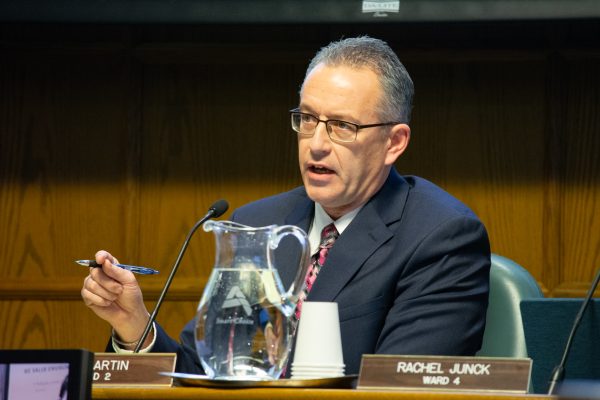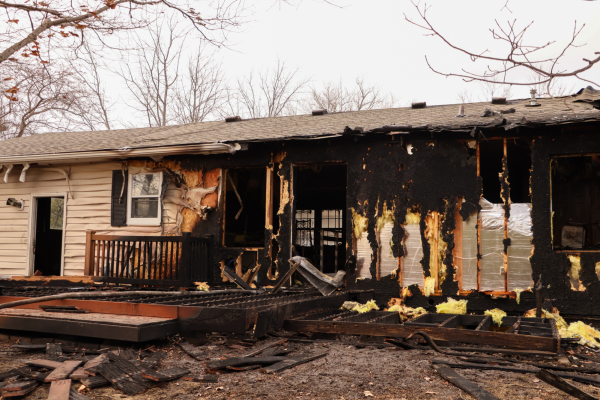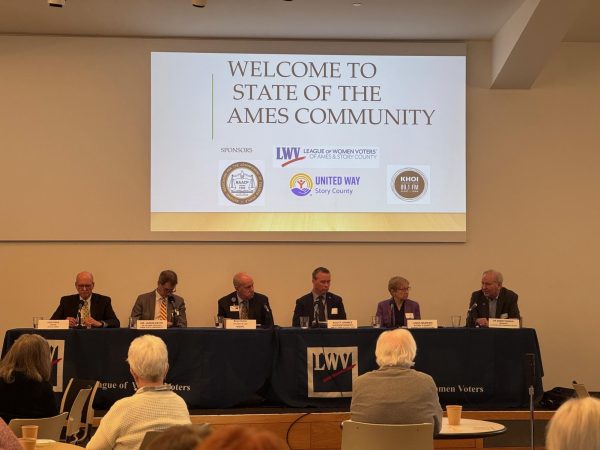City council directs city staff on urban housing development regulations
Ward 3 Rep. Anita Rollins listens to a presentation on Jan. 24.
The Ames City Council made several motions to gathering information on townhomes, cottage neighborhoods and intensification during their discussion on creating new housing requirements to balance density and style for the future of infill housing in the city.
Infill development refers to the process of developing unused or underutilized land within already established and developed areas, typically in urban or suburban settings. Ames City Planner and Housing Director Kelly Diekmann introduced the workshop Tuesday as a first step in implementing the Ames 2040 Plan, which calls for infill housing options that include accessory living units, two-family homes and designated planned infill sites.
Ward 1 Rep. Gloria Betcher said Mayor John Haila and City Manager Steve Schainker were on vacation, and she served as mayor pro-tempore for the meeting. Assistant City Manager Brian Phillips filled in for Schainker and At-large Rep. Amber Corrieri was absent.
City documents indicated south of Campustown, near-south downtown and east Lincoln Way as subarea and infill candidate areas.
“The Lincoln Way corridor, we have a land use designation called corridor – we have no zoning district to implement,” Diekmann said. “So right now if somebody wants to redevelop on Lincoln Way I have to say, ‘I’m sorry I know the [2040] plan is in favor of this, but I have no zoning district that allows for you to do what the plan wants to be done.’”
Diekmann also said current zoning does not allow for any new duplexes in low-density zoning districts and that townhomes are currently absent from the city code.
Planner Eloise Sahlstrom said the city has plenty of detached single-family homes and mid-rise apartment buildings but does not have middle housing like townhomes or cottage neighborhoods.
Sahlstrom also suggested to the council that they regulate townhomes to blend in with the neighborhood, as she characterized a slot home in city documents as looking like “a prison” and not providing desired street frontage.
Ward 2 Rep. Tim Gartin moved to direct staff to inform the council at a later meeting, what it would mean to add townhomes to the city code. The motion passed 5-0.
Another form of infill housing is cottage neighborhoods which city documents displayed as having single-family homes encircle a green space with a parking lot nearby.
Betcher said Haila has expressed interest in cottage neighborhoods at several past meetings. Gartin moved to direct staff to provide the council with a proposal for cottage neighborhoods which was unanimously approved.
Diekmann said whether or not the council was interested in having uniform greenage in front of homes, new driveway standards should require them soon.
The council will have to decide in the future on height regulations, bedroom requirements, lot coverage and whether existing residents can build accessory dwelling units (ADU) out of an existing property or whether it would have to be brand new construction.
“[Height] does cause privacy issues too; you’ll start to get those comments as we do more infill like ‘I got a window that looks right down into my backyard 20 feet above me, I never had that before,’” Diekmann said.
Diekmann also said the city has learned that just because there is a roof massing regulation, that does not mean a multistory building would match the houses next to it.
“One of the things I’ve been thinking a lot about regarding ADUs is that from the research I’ve done, they seem to increase the value of properties significantly and we have already got an affordability problem with our housing here in Ames,” Betcher said.
At-large Rep. Bronwyn Beatty-Hansen said that could be said about any home improvement project, to which Betcher responded that most home improvements are not $180,000.
“If you put a lot of money into renovating your home or making energy-efficiency upgrades and things like that – that’ll affect the value too, but we would never dream of saying ‘Let’s not do that to the old houses in town,” Beatty-Hansen said. “We want people to improve their properties, and part of improving the property is the value goes up.
According to city documents, after local governments permitted ADUs in Des Moines and Cedar Rapids in 2019, they have only approved a combined 13 ADUs.
Gartin said ADUs would likely be a small part of infill housing and motioned to direct staff to inform the council where they could change the zoning to improve intensification. The motion was approved 5-0.
On considering lot coverage, Betcher said the council should keep the Climate Action Plan in mind and did not think it was a good idea to adjust current lot coverage regulations.
Diekmann said the city staff will return to the council in April for more direction, and by then, he hopes the fate of a bill in the legislature to restrict cities to regulate housing designs is determined.
“It’s a little unclear right now until this legislative session is over how much we can do with design guidelines in terms of orientation, building, windows, materials – all of that,” Diekmann said.
Your donation will support the student journalists of the Iowa State Daily. Your contribution will allow us to purchase equipment, send our student journalists to conferences and off-set their cost of living so they can continue to do best-in-the-nation work at the Iowa State Daily.











